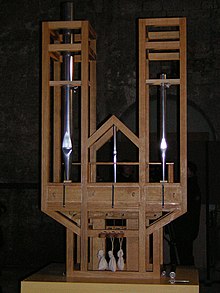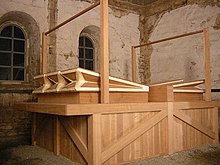As Slow as Possible

Organ²/ASLSP (As SLow aS Possible) is a musical piece composed by John Cage and is the subject of the slowest and longest-lasting musical performance yet undertaken. It was originally written in 1987 for organ and is adapted from the earlier work ASLSP 1985; a typical performance of the piano piece lasts for about 20 minutes. The current organ performance of the piece began in 2001 and scheduled to have a duration of 639 years, ending in 2640.
Background
A 1997 conference of musicians and philosophers discussed the implications of his instruction to play the piece "as slow as possible", given that an organ imposes virtually no time limits. A project emerged to perform the piece so that it would take a total of 639 years to play. This length was decided based on the estimated lifespan of the organ. The origin of this number is as follows: the piece was to be performed in the St. Burchardi church in Halberstadt, Germany, beginning in the year 2000; 639 years earlier, in the year 1361, the first big organ had been constructed in that church.
Performance
The actual performance commenced in the St. Burchardi church on September 5, 2001 with a pause lasting until February 5, 2003. The first chord was played from then until July 5, 2005, being joined by an E octave (E3-E4) on July 5, 2004. As of January 11, 2007, the most recent event from the organ was the end of this E octave chord on May 5, 2006, which had lasted a 'mere' 22 months.
The most recent new chord from the organ was a three-note chord, A above middle C, C above middle C and the F-sharp above that (A4-C5-F sharp5), which began on January 5, 2006 and is due to conclude on July 5, 2012. This sonority can be heard on a website devoted the Halberstadt event. [1]
The next musical event from the organ will be a new chord (C4-A flat4), which commences on July 5, 2008.
The performance is planned to continue until September 5, 2640.
The piece

Organ2/ASLSP is the slowest and longest lasting musical performance yet undertaken. The score consists of eight pages which have been stretched to fit the wanted duration of 639 years. This duration is the difference between the date of the installation of the ancient organ of 1361 and the originally planned start of the performance in 2000. This leads to a curve from 1361 over 2000 to 2639. Unfortunately, the performance was slightly delayed, and it began on September 5, 2001.
Organ2/ASLSP contains profoundly different musical material than its predecessor (pictured above). The performance instructions vary slightly, as well.
ASLSP Performance Note: The title is an abbreviation of "as slow as possible." It also refers to "Soft morning city! Lsp!" the first exclamations in the last paragraph of Finnegans Wake (James Joyce).
There are eight pieces, any one of which must be omitted and any one of which must be repeated. The repetition may be placed anywhere (even before its appearance in the suite) but otherwise the order of the pieces as written shall be maintained.
Neither tempo nor dynamics have been notated. Time proportions are given (just as maps give proportional distances). Accidentals apply only to those pitches they directly precede.
Each hand plays its own part and is not to be assisted by the other. A diamond-shaped note indicates a note to be depressed without sounding. All the notes have stems. The stem gives the point in time of the single note, interval or aggregate. A closed notehead tied to an open notehead indicates the end of a sustained sound. Sustained sounds are also sometimes notated with straight line-extensions.
In a performance a correspondence between space and time should be realized so that the music "sounds" as it "looks". —-- John Cage
The piece was commissioned by The Friends of the Maryland Summer Institute for the Creative and Performing Arts as a contemporary requirement for a piano competition. Cage employed an open format mainly to insure that no two performances would be the same, providing the judges a break from the monotony of most competitions.
Organ2/ASLSP does not allow for an omission of one of the pieces, but it does require one repetition.
Sound changes
The piece started with a rest of seventeen months, beginning September 5, 2001, which was the 85th anniversary of Cage's birth.[1] The first audible sound appeared on February 5, 2003. Further dates for changing notes are:
- July 5, 2004
- July 5, 2005
- January 5, 2006
- May 5 2006
- July 5, 2008
- November 5 2008
- February 5, 2009
- July 5, 2010
- February 5, 2011
- August 5 2011
- July 5, 2012
- October 5, 2013
- September 5, 2020
On these dates St. Burchardi usually is well visited. The sound change of January 5 2006 is available as an Audiofile.
The instrument

An organ is being built specifically for this performance and will be finished in 2009. It is standing in the right transept of the Burchardi-church, while the bellows are in the left. Between January and May 2005, it contained only six pipes. Due to the fact that the instrument sounds constantly, there is a cube of acrylic glass around it to reduce the sound emissions.
Memorial plaques

In the church there are memorial plaques, one for each year of the composition. Any person who donates at least 1000 EUR can get one plaque and define a text for it. On the webpage of the project there is a list of the plaques still available resp. years.
See also
References
External links
- Recordings of a nine-hour performance of ASLSP at ARTSaha! 2006 by Joseph Drew: Hour One, Hour Six, Hour Nine
- Website of the Halberstadt event
- First notes for 639-year composition, BBC News, 5 February 2003
- As Slow As Possible, Performance Today feature (National Public Radio), September 2003
- Template:De icon Die eingefrorene Zeit, Die Zeit, January 8 2006
- Website of the documentary film 'ASAP' by Scott Smith
